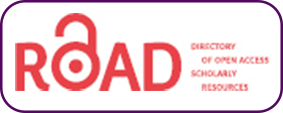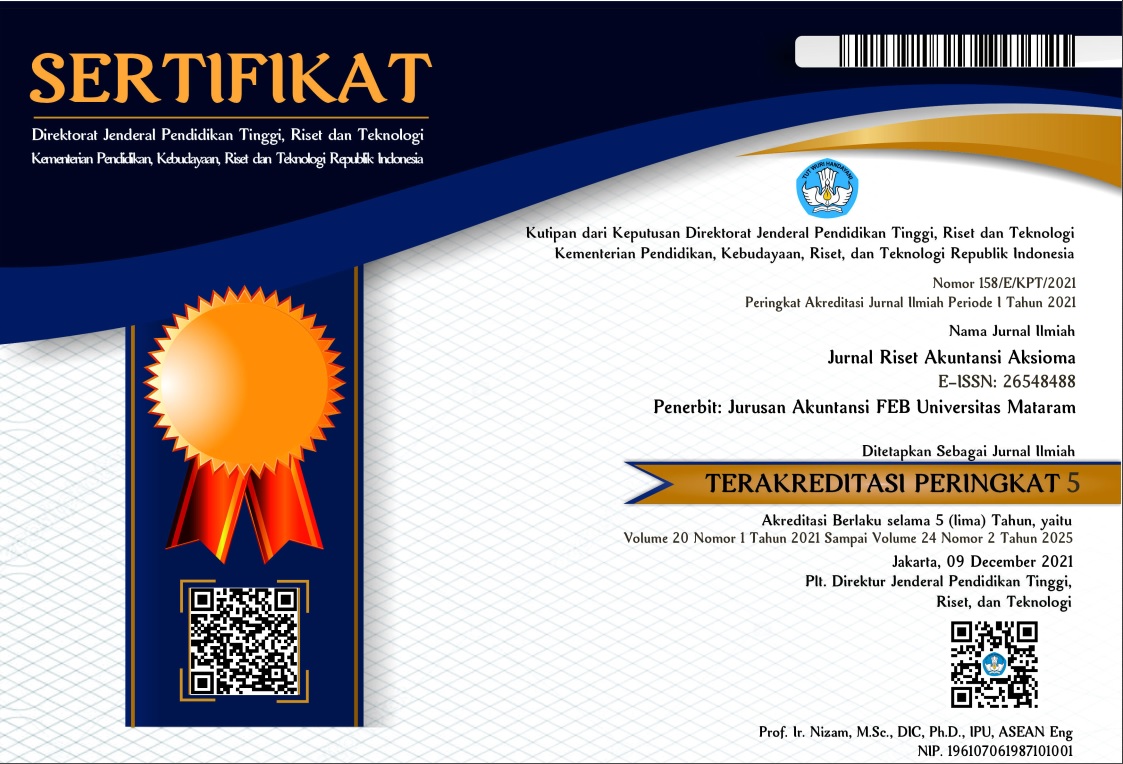PENGUNGKAPAN ANTI KORUPSI DAN KINERJA KEUANGAN PERUSAHAAN: STUDI KASUS PERUSAHAAN TERDAFTAR DI INDEKS SRI KEHATI
Abstract
Corruption within the corporation has become an important issue in the academic and public debate. The negative consequences caused by companies that engage in corruption are enormous, such as market distortion and incentives, resource allocation inefficiencies, as well as the increased of poverty and social inequality. Companies have the opportunity through a corporate responsibility (CSR) to prevent the problem of corruption. As important as labor, human and environmental rights, corruption mitigation is an important aspect in promoting CSR. CSR can be profitable in sales revenue and market share by improving the perception of ethical corporate customers. However, with the involvement of corruption, it can reduce the confidence of investors and the public against the company which may result in reduced financial performance. The purpose of this study is to determine empirically the correlation of anti-corruption disclosure reported by the companies listed in the Sri Kehati Index and FTSEGoods Bursa Malaysia Index on their financial performance, both the short and long term. The results showed that only the whistle blowing policies were fully disclosed by all companies in the sample of this study. The results also show that the disclosure of anti-corruption has significant influence on the company's profitability only in the long term for companies registered in Sri Kehati Indonesia index. As for the sample of companies registered in Malaysia FTSEGoods Index, the results showed that the disclosure of anti-corruption affect the company's financial performance both in the short term and in the long term. This implies that investors were responding to the anti corruption issues disclosed by the companies and companies should keep the disclosure practice in the future.
Keywords: anti-corruption, corporate social responsibility, disclosure, financial performance.
References
Akhtaruddin, M, Hossain, MA, Hossain, M & Yao, L 2009, ‘Corporate governance and voluntary disclosure in corporate annual reports of Malaysian listed firms’, Journal of Applied Management Accounting, vol. 7, no. 1, pp. 1–17.
Arafa, Mohameed A. Battling Corruption within a Corporate Social Responsibility Strategy. Indiana International & Comparative Law Review, Vol. 21, No. 3, 2011. Available in http://papers.ssrn.com/sol3/papers.cfm?
abstract_id=1933629
Bierstaker, J.L., 2009. Differences in attitudes about fraud and corruption across cultures: theory, examples and recommendation. Cross Cult. Manag. Int. J. 16, 241e260.
Chapple, W., Moon, J., 2005. Corporate Social Responsibility (CSR) in Asia: a sevencountryvstudy of CSR Website reporting. Bus. Soc. 44, 415e441.
Chen, JC & Roberts, RW 2010, ‘Toward a more coherent understanding of the organization-society relationship: A theoretical consideration for social and environmental accounting research’, Journal of Business Ethics, vol. 97, no. 4, pp. 651–665.
Cochran, P. L., & Wood, R. A. 1984. Corporate social responsibility and financial performance. Academy of Management Journal, 27, 42-56
Coonjohn, J.J., Lodin, A., 2011. Developing a Strategic Implementation Plan for Anticorruption. Retrieved from: http://www.jjcoonjohn.com/pdf/
Strategic_Implementation_Plan.pdf
Cuganesan, S., Ward, L. & Guthrie, J. 2007. Legitimacy theory: a story of reporting social and environmental matters within the Australian food and beverage industry. Dipresentasikan pada 5th Asian Pacific Interdisciplinary Research in Accounting (APIRA) Conference, 8-10 Juli 2007, Auckland, New Zealand. Diakses 3 Maret 2012 dari: http://ssrn.com/abstract=1360518
Dahlia, Lely dan Sylvia Veronica Siregar. 2008. Pengaruh Corporate Social Responsibility terhadap Kinerja Perusahaan. Simposium Nasional Akuntansi 11, Pontianak
Dissanayake, T., Islam, M.A., Dellaportas, S., 2011. In: Corporate Disclosure on Combatting Bribery: a Study of Two Global Companies in the Telecommunication Industry Paper Presented at the 10th Australasian Conference on Social and Environmental Accounting Research (CSEAR), 5e7 December. University of Tasmania, Australia.
Doh, J., Rodriguez, P., Uhlenbruck, K., Collins, J. and Eden, L. (2003) ‘Coping with Corruption in Foreign Markets’, Academy of Management Executive 17 (3): 114-127.
Elkington, J. 2005. Cannibals with forks,the triple bottom line of twentieth century business. Dikutip dari Teguh Sri Pembudi. CSR. Sebuah Keharusan dalam Investasi Sosial. Pusat Penyuluhan Sosial (PUSENSOS) Departemen Sosial RI. Jakarta. La Tofi Enterprise.
Gray, R, Kouhy R & Lavers, S. 1995. Corporate social and environmental reporting: A review of the literature and a longitudinal study of UK disclosure. Accounting, Auditing & Accountability Journal, vol. 8, no. 2, pp. 47–77.
Gray, R, Owen, D & Adams, C .1996. Accounting and accountability: Changes and challenges in corporate social and environmental reporting. Prentice Hall, London.
Gunawan, J., 2007. Corporate social disclosures by Indonesian listed companies: a pilot study. Soc. Responsib. J. 3, 26e34.
Guthrie, J, Petty, R. and Yongvanich, K. 2004 ‘Using content analysis as a research method to inquire into intellectual capital reporting’, Journal of Intellectual Capital, 5(2):282-293
Haniffa, RM & Cooke, TE 2002, ‘Culture, corporate governance and disclosure in Malaysian corporations’, ABACUS, vol. 38, no. 3, pp. 317–349.
Heal, Geoffrey, dan Garret, Paul. 2004. Corporate Social Responsibility, An Economic and Financial Framework. Columbia Business School.
Healy, P., Serafeim, G., 2011. Causes and Consequences of Firms Disclosures of Anti-corruption Efforts. Working Paper. Harvard Business School.
Healy, P., Serafeim, G., 2014. An Analysis of Firms' Self-reported Anti-corruption Efforts. Working Paper. Harvard Business School.
Hess, D., 2009. Catalyzing corporate commitment to combatting corruption. J. Bus. Ethics 88, 781e790.
Hills, G., Fisk, L., Mahmud, A., 2009. Anti-corruption as Strategic CSR: a Call toAction for Corporations. Retrieved from: www.ethics.org/files/u5/
AnticorruptionFINAL.pdf.
Hillman, A. J., & Keim, G. D. 2001. Shareholder value, stakeholder management,and social issues: what’s the bottom line? Strategic Management Journal, 22, 125-139.
Hoi, Y.H., Lin, C.Y., 2012. Preventing corporate corruption: the role of corporate social responsibility strategy. Int. J. Bus. Behav. Sci. 2, 12e22.
Hull, C. E., & Rothenberg, S. 2008. Firm performance: the interactions of corporate social performance with innovation and industry differentiation. Strategic Management Journal, 29, 781-789.
Indriantoro, Nur. 2002. Metodologi Penelitian Bisnis untuk Akuntansi dan Manajemen. Cetakan 2. BPFE-Yogyakarta. Yogyakarta
Islam, M. & Deegan, C., (2008), ‘Motivations for an organisation within a developing country to report social responsibility information: Evidence from Bangladesh’, Accounting Auditing & Accountability Journal, Vol. 21, No. 6, pp. 850-874.
Islam, M. & Deegan, C., (2010), ‘Media Pressures and Corporate Disclosure of Social Responsibility Performance: A Case Study of Two Global Clothing and Sports Retail Companies’, Accounting and Business Research Journal, Vol 40, No.2. pp.131-148.
Jensen, M. C., & Meckling, W. H. 1976. "Theory of The Firm: Managerial Behavior, Agency Costs and Ownership Structure". Journal of Financial Economic. 3, 305--360.
Joseph, C., Gunawan, J., Sawani, Y., Rahmat, M., Noyem, J.A., Darus, F. 2015. A comparative study of anti-corruption practice disclosure among Malaysian and Indomesian Corporate Social Responsibility (CSR) best practice companies. Journal of Cleaner Production xxx 1-11.
Kang, K. H., Lee, S., & Huh, C. 2010. Impacts of positive and negative corporate social responsibility activities on company performance in the tourism industry. International Journal of Hospitality Management, 29(1), 72-82.
KPMG, 2008. KPMG International Survey on Corporate Responsibility Reporting.
Lange, D. A. (2008). A multidimensional conceptualization of organizational corruption control. Academy of Management Review, 33: 710-729.
Luo, X., & Bhattacharya, C. B. 2006. Corporate social responsibility,
customer satisfaction, and market value. Journal of Marketing, 70, 1-18.
McWilliams, A., & Siegel, D. 2000. Corporate social responsibility and financial
performance: correlation or misspecification? Strategic Management Journal, 21(5), 603-609.
National Geographic, 2015. Asia: Resources Environment and Economy. Retrieved from: http://education.nationalgeographic.com/education/
encyclopedia/asiaresources/?ar_a¼1.
O’Higgins, E. (2006). Corruption, underdevelopment, and extractive resource industries: Addressing the vicious cycle. Business Ethics Quarterly, 16: 235-254.
OTSI, 2010. Fraud and Corruption Prevention Strategy. The Office of Transport Safety. Retrieved from: www.otsi.nsw.gov.au/access-to-info/OTSI-Fraud- Strategy.pdf.
Osuji, O. (2011). Fluidity of regulation-CSR nexus: the multinational corporate corruption example. Journal of Business Ethics, 103: 31-57.
Political & Economic Risk Consultancy Ltd, 2011. S.W.O.T. Study of Asia's Emerging Countries. Retrieved from http://www.asiarisk.com/
library2.pdf.
Roberts, R.W.: 1992, 'Determinants of Corporate Social Responsibility Disclosure: AnApplication of Stakeholder Theory', Accounting, Organizations and Society 17(6), 595-612.
Sayekti, Y., & Wondabio, L. S. (2007). Pengaruh CSR Disclosure terhadap Earning Response Coefficient. Paper presented at the Simposium Nasional Akuntansi X.
Solimun, 2007, Memahami Metode Kuantitatif Mutakhir Structural Equation
Modeling & Partial Least Square. Program Studi Statistika FMIPA Universitas Brawijaya Malang.
Transparency International, 2009a. Transparency in Reporting on Anti-corruption. A Report on Corporate Practices, Berlin.
Transparency International, 2010. Corporate Responsibility & Anti-corruption: the Missing Link, Working Paper. Retrieved from: www.transparency.org
Transparency International, 2014. Corruption Index Improve but Still Not Encouraging. Retrieved from: http://www.dw.de/indeks-korupsi-peringkat-indonesiamembaik-tapi-masihburuk/a18107694.
Transparency International, 2015. Archive Link. Retrieved from: http://archive.transparency.org/news_room/faq/corruption_faq.
Ullmann, A.A.: 1985, 'Data in Search of a Theory: A Critical Examination of the Relationshipsamong Social Performance, Social Disclosure, and Economic Performance of U.S. Firms', The Academy of Management Review 10(3), 540-557.
van Dijken, Francisca, .2007. Corporate social responsibility: market regulation and the evidence. Managerial Law, Vol. 49 Iss: 4, pp.141 - 184
Walden, W.D. and Schwartz, B.N. 1997, “Environmental disclosures and public
policy pressure”, Journal of Accounting and Public Policy, Vol. 16 No. 2, pp. 125-54.
Weyzig, F., 2009. Political and economic arguments for corporate social responsibility: analysis and a proposition regarding the CSR Agenda. J. Bus. Ethics 86, 417e428.
www.globalreporting.org
Undang-Undang Republik Indonesia No. 40 Tahun 2007 tentang Perseroan Terbatas. Retrieved February 28, 2008, from http://bapepam.go.id/reksadana/files/regulasi/UU%2040%202007%20Perseroan%20Terbatas.pdf




















